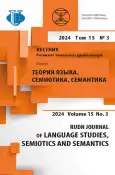Expression, Thinking, and Cognition: Origins of Differences between the Russian and Chinese Languages
- 作者: Zhang K.1, Denisenko V.N.2
-
隶属关系:
- Northeast Normal University
- RUDN University
- 期: 卷 15, 编号 3 (2024)
- 页面: 841-855
- 栏目: SEMIOTICS AND SEMANTICS
- URL: https://journal-vniispk.ru/2313-2299/article/view/323589
- DOI: https://doi.org/10.22363/2313-2299-2024-15-3-841-855
- EDN: https://elibrary.ru/HXKOXQ
- ID: 323589
如何引用文章
全文:
详细
Comparative study of languages reflects the coexistence of the universal and the particular in human languages. The development of both typological linguistics and contrastive linguistics is primarily associated with the study of structural similarities and differences between languages based on structural criteria for comparison. However, cognitive operations and forms of thinking that characterize the structural organization of expressed thoughts are fundamental mechanisms governing the functioning of various languages. In this study, a comparative analysis is presented as of the structural features of Russian subjectpredicate sentences and Chinese topic-comment sentences. Special attention is paid to different forms of thinking (rational and figurative) that underlie the differences in language structure between the two languages, as well as various cognitive processes (recognizing analogies and associations) that shape vertical and horizontal categorization, resulting in differences in thought patterns. As a result of the conducted study, the authors conclude that the form of thinking determines the form of language structure. The formation and functioning of different forms of language structure are operations and reflections of different forms of thinking in various language structures. Rational and figurative thinking, with their respective characteristics, limit and define the structural forms of Russian and Chinese languages. At the sentence level, it manifests basic structures both in Russian where the basic sentence structure is “subject-predicate,” while in Chinese it is “topic-comment.”.
作者简介
Ke Zhang
Northeast Normal University
编辑信件的主要联系方式.
Email: zhangk176@nenu.edu.cn
ORCID iD: 0000-0002-7765-2133
Researcher ID: D-7768-2019
PhD in Philology, Senior Teacher of the Department of Russian Language
5268, Renmin Street, Changchun, Jilin Province, China, 130024Vladimir Denisenko
RUDN University
Email: denisenko-vn@rudn.ru
ORCID iD: 0000-0001-6021-4068
SPIN 代码: 4635-8342
Scopus 作者 ID: 57193133860
Researcher ID: AAG-9635-2020
Dr.Sc. (Philology), Professor, Head of the of the General and Russian Linguistics Department
6, Miklukho-Maklaya Str., Moscow, Russian Federation, 117198参考
- Li, Ch. & Thompson, S. (1982). Subject and topic: a new typology of subject languages In: New in foreign linguistics. Iss. XI: Modern syntactic theories in American linguistics. Moscow: Progress. (In Russ.).
- Kurdyumov, V.A. (2014). The morphological level of the Chinese language as isolating topicprominent. The essence and content of the particle position. MCU journal of philology. theory of linguistics. Linguistic education, 1(13), 37–46. (In Russ.).
- Shi, Dingxu. (2000). Topic and Topic-Comment Constructions in Mandarin Chinese. Language, 76(2), 383–408.
- Skvortsov, A.V. (2022). Structural Classification of Topic Sentences in Chinese from Different Periods. Philology. Theory & Practice, 15(4), 1260–1267. https://doi.org/10.30853/ phil20220192. (In Russ.).
- Kurdyumov, V.A. (1999). Idea and Form. Foundations of the Predicative Concept of Language. Moscow: Military University. (In Russ.).
- Kurdyumov, V.A. & Kozyk, K.E. (2020). On the Differentiation of the Concepts «TopicComment» and «Theme-Rheme». Bulletin of the Russian New University. Series “Human in the Modern World”, 1, 86–93. https://doi.org/10.25586/RNU.V925X.20.01.P.086. (In Russ.).
- Zimmerling, A.V. (2008). Zero Lexemes in Syntax: Dogmatics and Typology. Acta Linguistica Petropolitana. Proceedings of the Institute of Linguistic Studies, 2(4), 226–244. (In Russ.).
- Kurdyumov, V.A. & Semenova, L.A. (2022). General Concepts of Metaphor and Metaphor in Chinese. MCU Journal of Philology. Theory of Linguistics. Linguistic Education, 3(47), 90–98. https://doi.org/10.25688/2076-913X.2022.47.3.07. (In Russ.).
- Fiengo, R. & May, R. (1994). Indices and identity. Cambridge, MA: MIT Press.
- Qiu Sh. (2017). Cognitive Approach to English-Chinese Contrastive Linguistics. Foreign Languages in China, 14, 35–44. (In Chinese). 邱述德. 英汉对比语言学研究的认知途径. 中国外语. 2017(14), 35–44页.
- Cai, Sh. (2020). On Language Status and Language Function in Human Cognition. Journal of Peking University (Philosophy and Social Sciences), 57(01), 138–149. (In Chinese).
- Jiang, G. (2024). Linguistic Relativity and Cognitive Linguistics: Two Positions on the Language-thinking Correlation. Foreign Language Research, 02, 92–97. (In Chinese). 蒋 国辉. 语言相对论与认知语言学:语言—思维相关性的两种立场. 外语学刊. 2024(02), 92–97页.
- Cui, Y. & Wei, Y. (2024). From Language to Thought: The Systems Thinking Coordination Mechanism Approach [J/OL]. JOURNAL OF SYSTEMS SCIENCE. URL: http://kns.cnki.net/kcms/detail/14.1333.N.20240416.1707.002.html. (accessed: 05.04.2014). (In Chinese). 崔艳英, 魏屹东. 从语言到思维:系统思维的协调机制探析. 系统科学学报. 2024. http://kns.cnki.net/kcms/detail/14.1333.N.20240416.1707.002.html.
- Wen X. & Yu P. & Si, W. (2019). Category-Based Transformation in Translation and Its Cognitive Interpretation. Chinese Translators Journal, 40(03), 33–43. (In Chinese). 文旭, 余平, 司卫国. 翻译的范畴转换及其认知阐释. 中国翻译. 2019. 40(03), 33–43页.
- Hu, P. & Wu, F. (2023). Database of Cross-Linguistic Colexifications and the Studies of Lexical Typology. Contemporary Linguistics, 25(04), 562–576. (In Chinese). 胡平、吴福祥. 跨语言同词化数据库与词汇类型学研究. 当代语言学. 2023. 25(04), 562–576页.
- Abisheva, K.M. (2013). Categorization and Its Main Principles. Issues of Cognitive Linguistics, 2(035), 21–30. (In Russ.).
- Kubryakova, E.S. (1999). The Semantics of the Cognitive in Linguistics (on Principles, Containers, and Forms of Their Objectification in Language). The Bulletin of the Russian Academy of Sciences: Studies in Literature and Language, 58 (5–6), 3–99. (In Russ.).
- Langacker, R.W. (1987). Foundations of Cognitive Grammar. Theoretical Prerequisites. Stanford, California: Stanford University Press.
- Boldyrev, N.N. (2000). Cognitive Semantics: A Course of Lectures on English Philology. Tambov: Tambov State University Publ. (In Russ.).
补充文件









